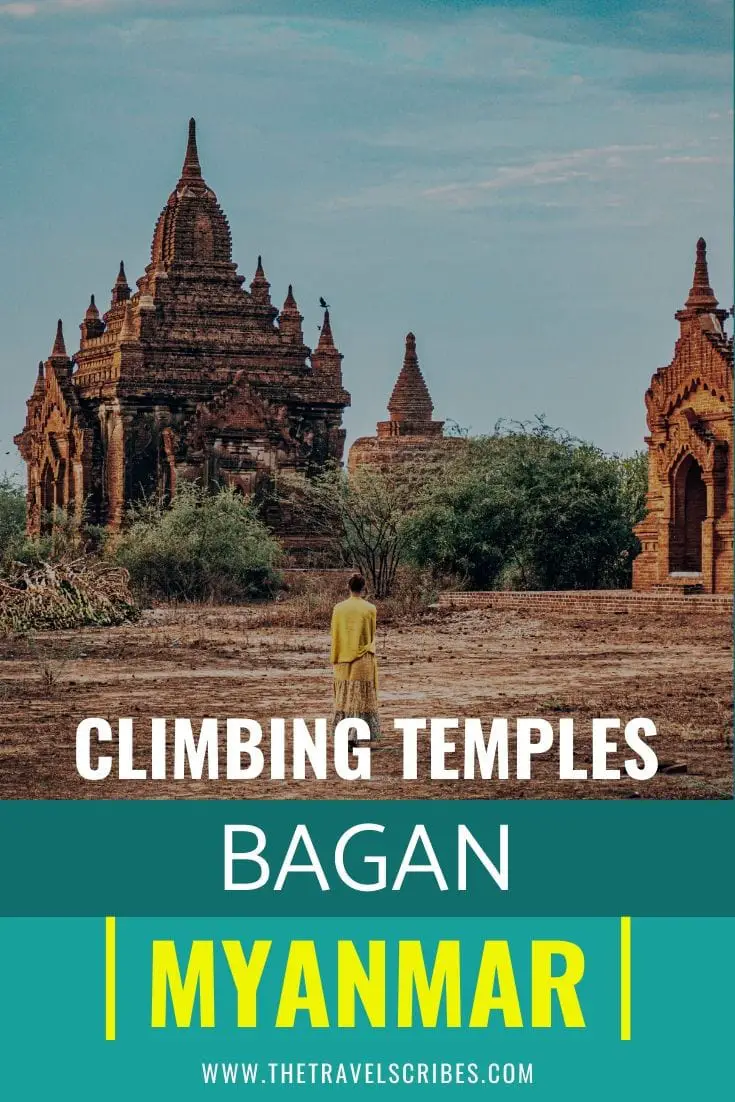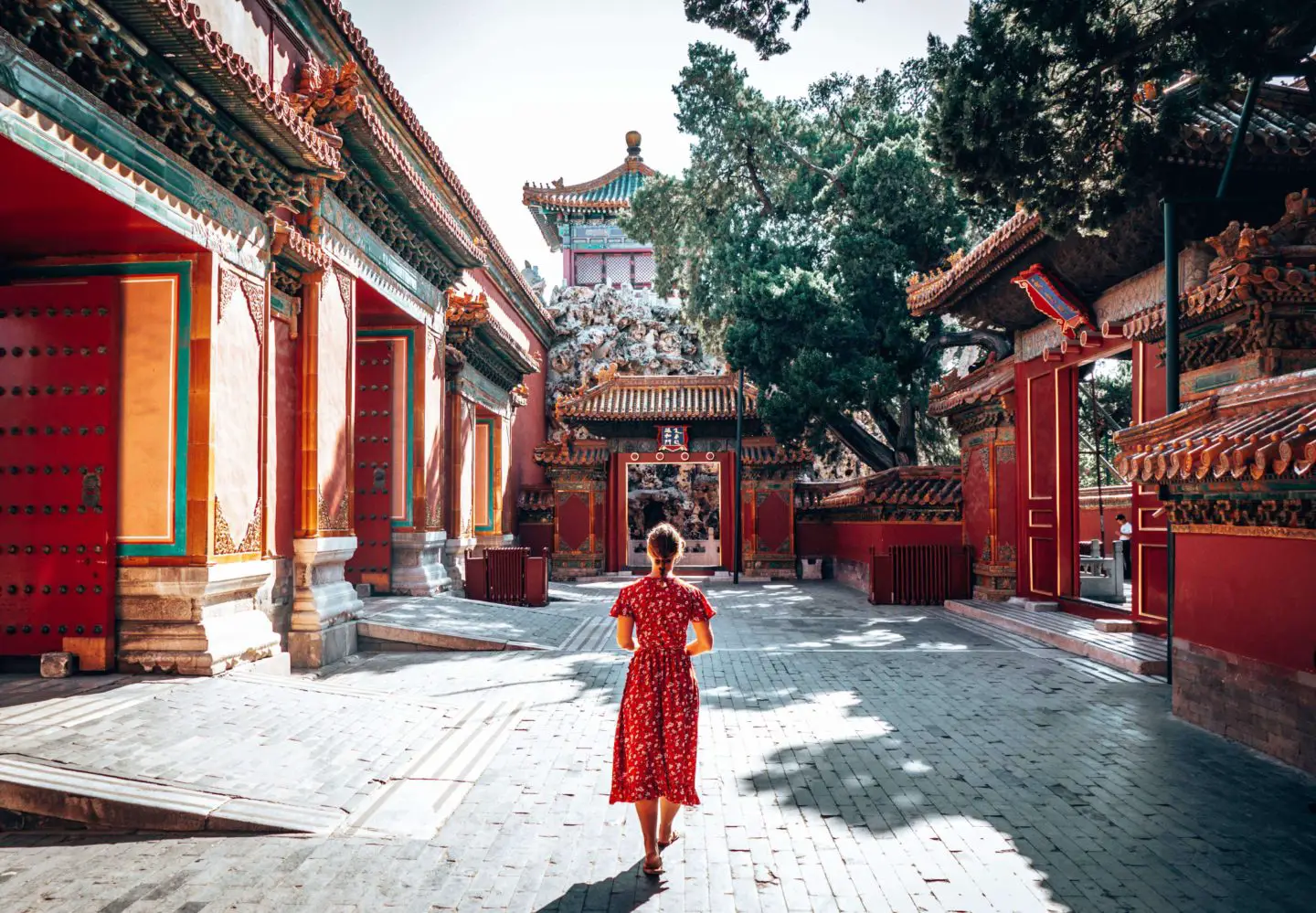So, you’ve reached this article since you’re either in Bagan or planning your trip there, and you want the lowdown on everything to do in Bagan, which temples are the best to visit and, probably, most of all if any of these can still be climbed? We’ll definitely be delivering on the first as our Bagan Temple Guide outlines the best places to eat, where to stay, how to get around and so much more. For the latter, legally you can’t really climb the temples anymore but we’ll explore a few tricks, suggest the best ones and even have a very handy Bagan temples map, to make sure that you know where to go!
So, whatever you need, we’ll be giving you (what we think is) the best guide to Bagan. Although if there are any travel tips that we haven’t covered in the article, do get in touch with us or drop us a comment below…!
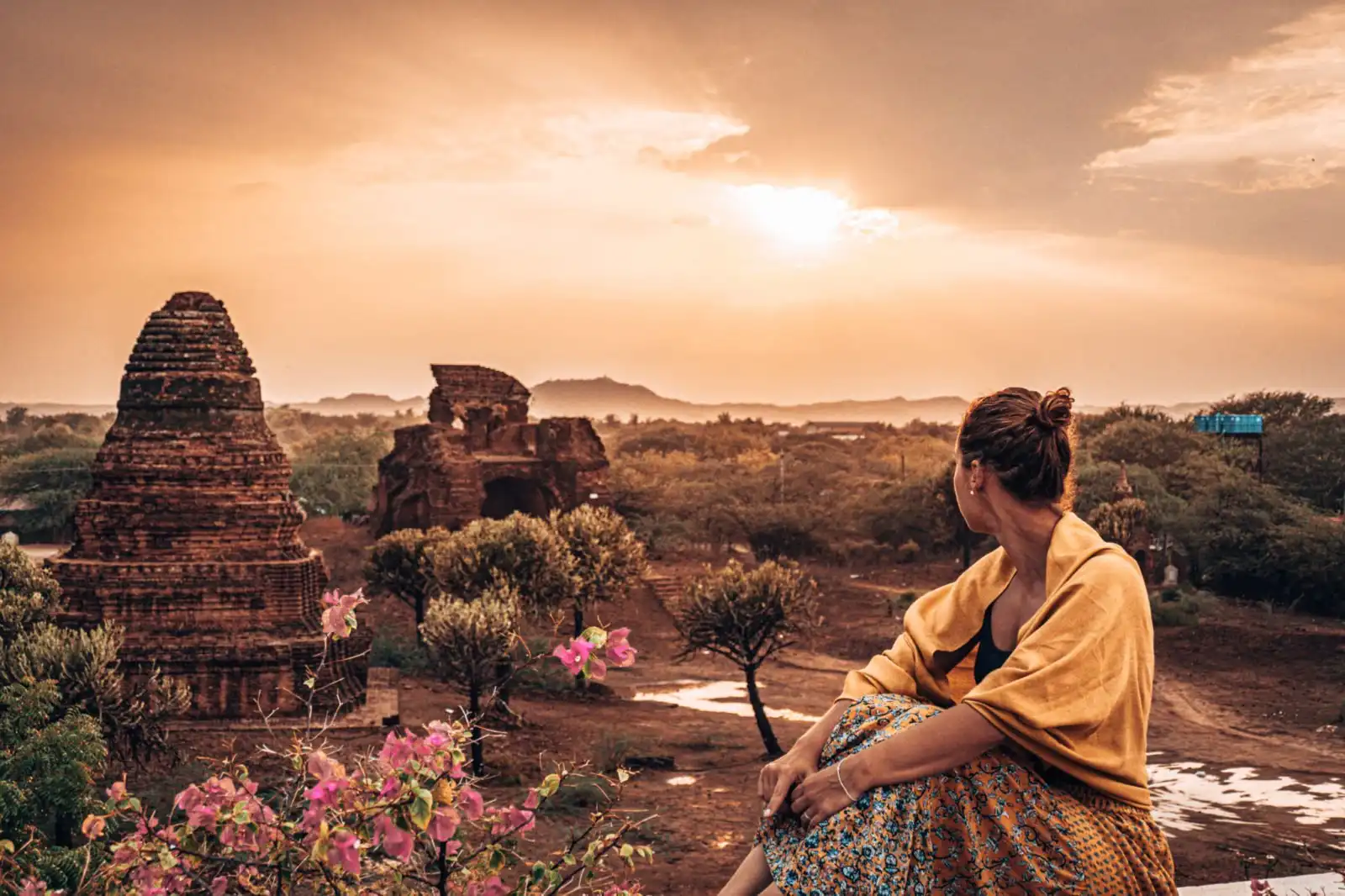
Skip ahead
Why visit Bagan?
Since he was turned away at the border over 18 years ago, James has been desperate to get into Myanmar. Now that the country is a little more geared towards tourism we just HAD to visit, with his heart set on seeing Bagan, the town known for its thousands of temples and for Instagram-worthy content of sunrise (and sunset) punctuated by hot air balloons.
We went out of balloon season (which runs from October to April) but it was no less atmospheric; we’d still count it as one of our favourite places in the world. Literally every picture of Bagan is breath-takingly beautiful.
This place is truly magical. Each morning we got up long before the sun, swung our sleepy selves onto our trusty e-bike, and raced around the dusty streets, pulling over to find the perfect dawn-breaking view. And, after a midday nap and a green mango salad, we’d head out again in the cool evenings to catch the rays fading into twilight.
But probably the most important reason for why you just have to visit Bagan, is that unlike many other historical sites in Southeast Asia, Bagan (and Myanmar in general) is not on the normal traveller’s trail. It is slightly off the beaten path, which means that this place isn’t overcrowded. That said, we can’t see it staying like that forever, so head there now, before it does!
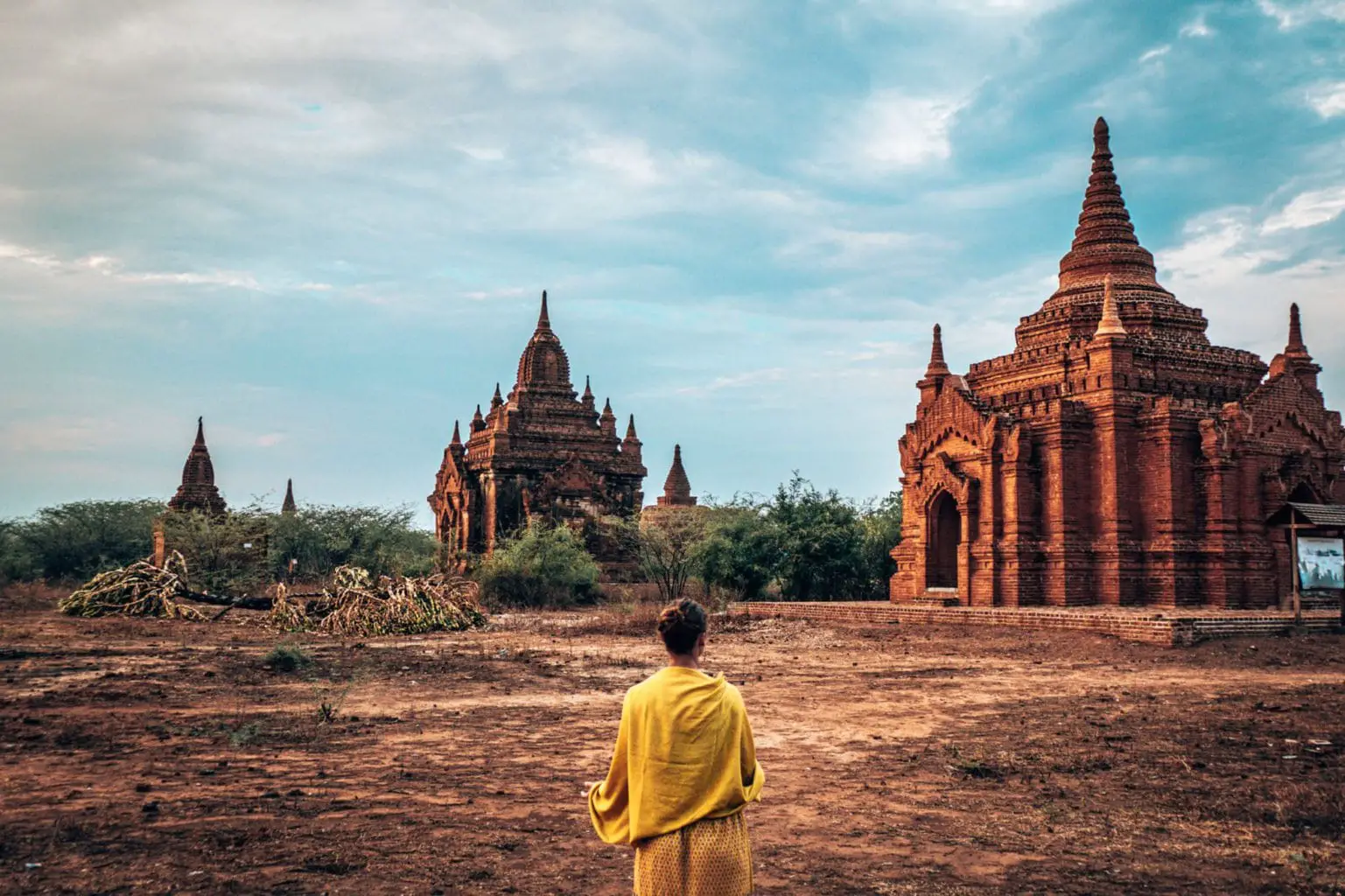
How to get to Bagan
So, you’ll in all likelihood be travelling to Bagan from either Yangon or Mandalay – and surprisingly there are really good options for both routes:
From Yangon to Bagan
Bus: We actually chose to take the overnight bus from Yangon to Bagan and were really very pleasantly surprised by how great it was. We travelled with JJ Express who are probably the best operator in the region. The distance from Yangon to Bagan is a 630 km journey, which will take around 8 to 9 hours. Click here for the latest prices and options.
Flight: If you’re a bit more pushed for time on your trip or just aren’t that keen on a night bus, then there are also several daily flights from Yangon to Bagan. Check out the latest prices here.
Train: Having watched a few videos on the journey (check out this one) and hearing the many stories of 20+ hour journeys that are dusty, bumpy and pretty uncomfortable, we decided to give this one a miss. Although if you’re really keen for an adventure… why not?
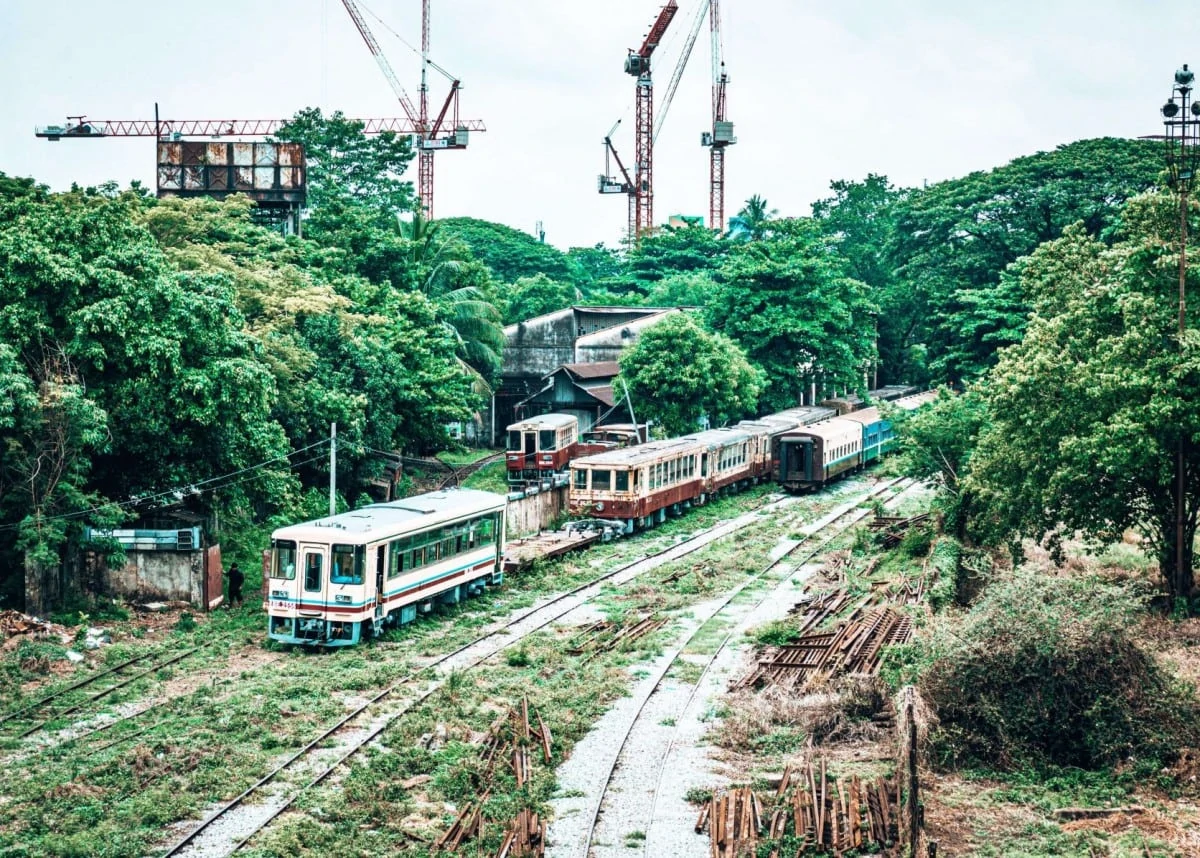
If you’re looking for some inspiration for what to do in Yangon, we also have a great 3 days in Yangon itinerary that may help you plan for your time in this wonderful, vibrant city.
Related: Street Art in Yangon
From Mandalay to Bagan
Bus: Once again, although we did this journey in reverse, the JJ Express bus was an excellent way to travel between Bagan and Mandalay. The 5-hour journey departs once a day, although there are also other operators which I’m sure offer a similar good service. Check out the latest departure times and ticket prices here.
Private transfer: If you want to travel in a bit more comfort, you can consider a private transfer between the two towns. Check out the latest prices here.
How long do you need in Bagan?
If we were putting together the perfect Myanmar itinerary, we’d allow for a minimum of 4 days in Bagan as part of that. Although, we personally spent 5 days in Bagan, we could have easily stayed for a couple of weeks and not been bored.
There is so much to explore, great places to eat, a really friendly vibe to the area and wonderful locals that you need to allow for a minimum of 4 days in Bagan. Any less than that and you’re not doing the place the justice it deserves.
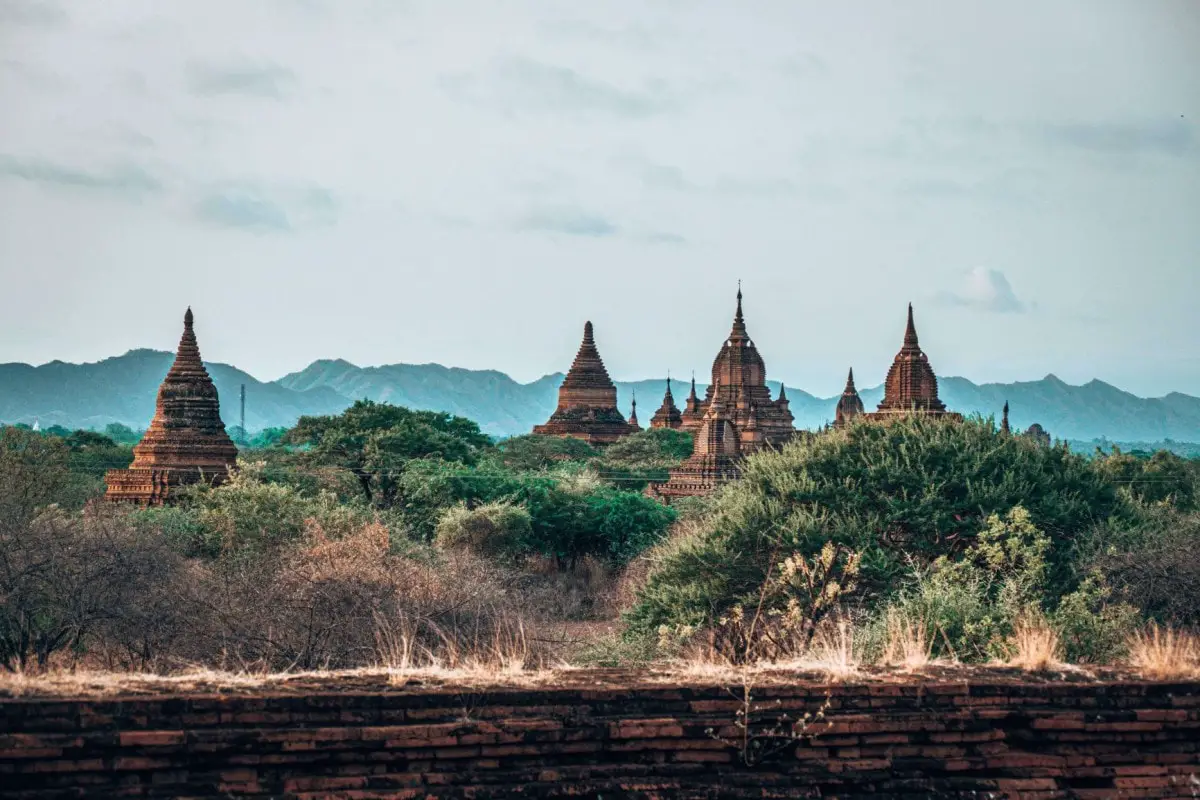
The history of Bagan
Once home to over 10,000 temples but, due to earthquakes and lack of adequate maintenance, estimates are at about 2,000 left. Still that is a mind-boggling number of temples and pagodas to explore.
So how did it come about that this patch of desert became home to one of the most iconic landmarks in Myanmar?
Set in the central plains of Myanmar, Bagan started out as a small settlement on the edge of the Irrawaddy River, founded in around the 9th century, and by the middle of the 11th century became the capital of the Pagan Kingdom.
Over the next 200 years, until the late 13th century, the Pagan kingdom would flourish, becoming a major centre for religion, attracting monks from all over Southeast Asia, and it was during this time that the construction of all these amazing temples took place.
The good news is that since July 2019, Bagan has been added to the UNESCO list as a UNESCO World Heritage site, which should mean that it will be better restored and protected in the future.
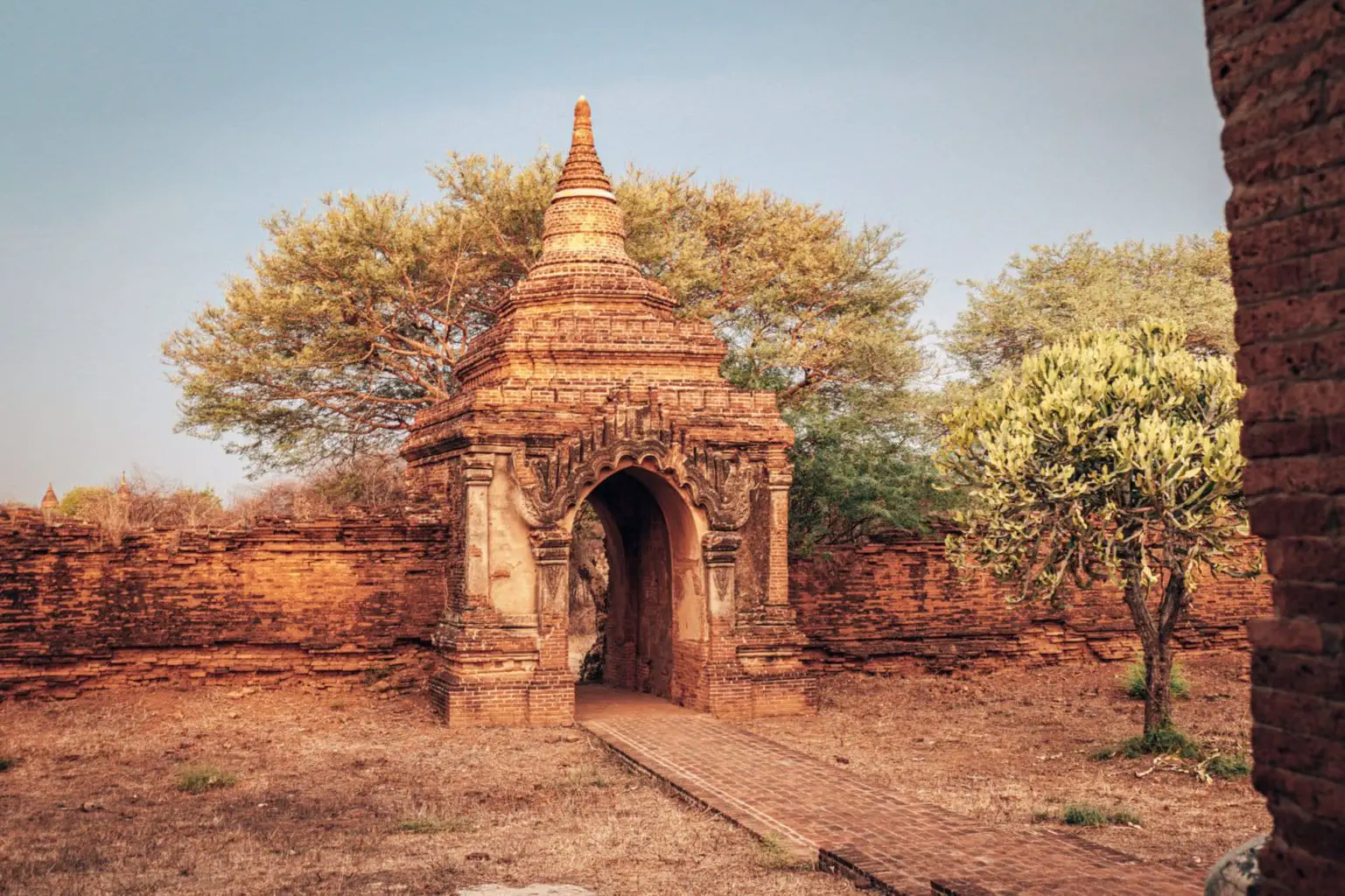
Climbing the temples of Bagan
First up, the golden question – are all the pagodas closed for climbing?
The short answer? Yes. The longer one? Depending on how much you’re willing to spend and your stomach for illegal pursuits…
You might know that the government has closed down the stairs on all the temples, meaning they are no longer ‘climbable’. The reasons for these seem to be unknown: corruption, previous injuries, their bid to make Bagan a heritage site are all bandied about as options, but no-one truly knows why they’ve taken this decision.
Instead, they’ve constructed viewing mounds at strategic points. Luckily, we’ve got the best listed out below, so you know where to go.
Overall, the mounds are okay but not only are they heaving with tourists, they just don’t offer the same experience as watching a sunrise from atop a temple. More so, many of the temples and pagodas are BUILT for climbing so it seems like a huge shame. It’s almost like going to Angkor Wat and not being allowed into the temple.
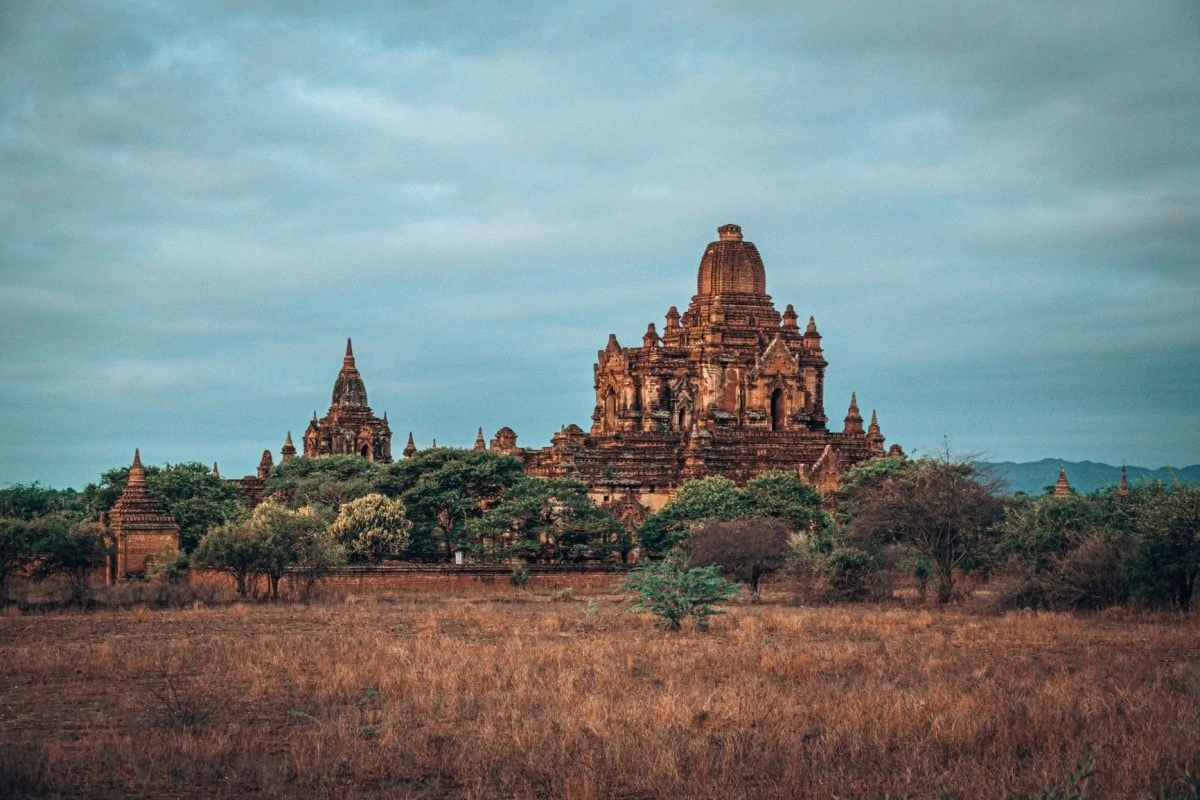
But what about the photos of people on Instagram atop these pagodas?
Closing the temples also hasn’t stopped people climbing them.
Now, though, instead of a moderately safe and controlled environment, the back streets are full of gung-ho travellers, all armed with secret maps and frantically dodging police to find a temple with a view. We met travellers who had scaled locked gates, who were slipping off the side of unsafe pagodas and ruins in their attempt to summit them, and the whole thing just felt like an accident waiting to happen.
Legally, you are not allowed to scale the temples any longer and most gates are closed and local police roam the more popular spots. There are one or two exceptions, like the Bagan viewing mounds or a few temple ruins but, on the whole, you need to view sunrise or sunset from the ground.
However, if you are willing to take a chance, there are of course ways to do so. We wouldn’t advocate doing anything unlawful but, if we’re honest, there are two ways for you to ascend one – self-guided or with local knowledge…
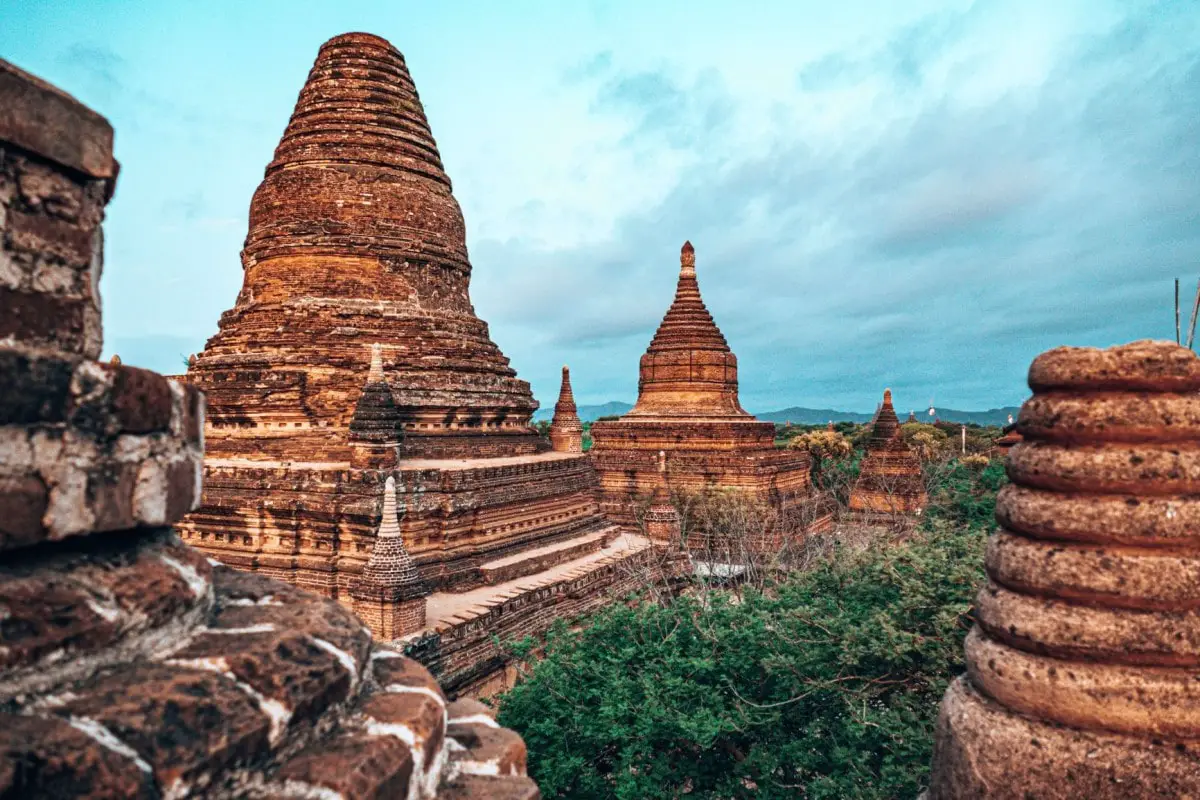
The best options for exploring the Bagan Temples?
Self-guided
Many people will attempt to evade police by surreptitiously waiting for just before sunrise or sunset and then clambering up the side. They find the temples using maps.me (more on that below) and swapping war stories and tips with other travellers over dinner at their hostels each night.
We would NOT recommend this approach.
We saw travellers pulled up by local police and forced to come off the temples (whether they paid a fine or paid off the police we’re unsure) but more so, these people spent most of their days in Bagan just chasing an unattainable experience. They often seemed to leave disappointed after spending all morning planning and driving, yet left in the proverbial dust.
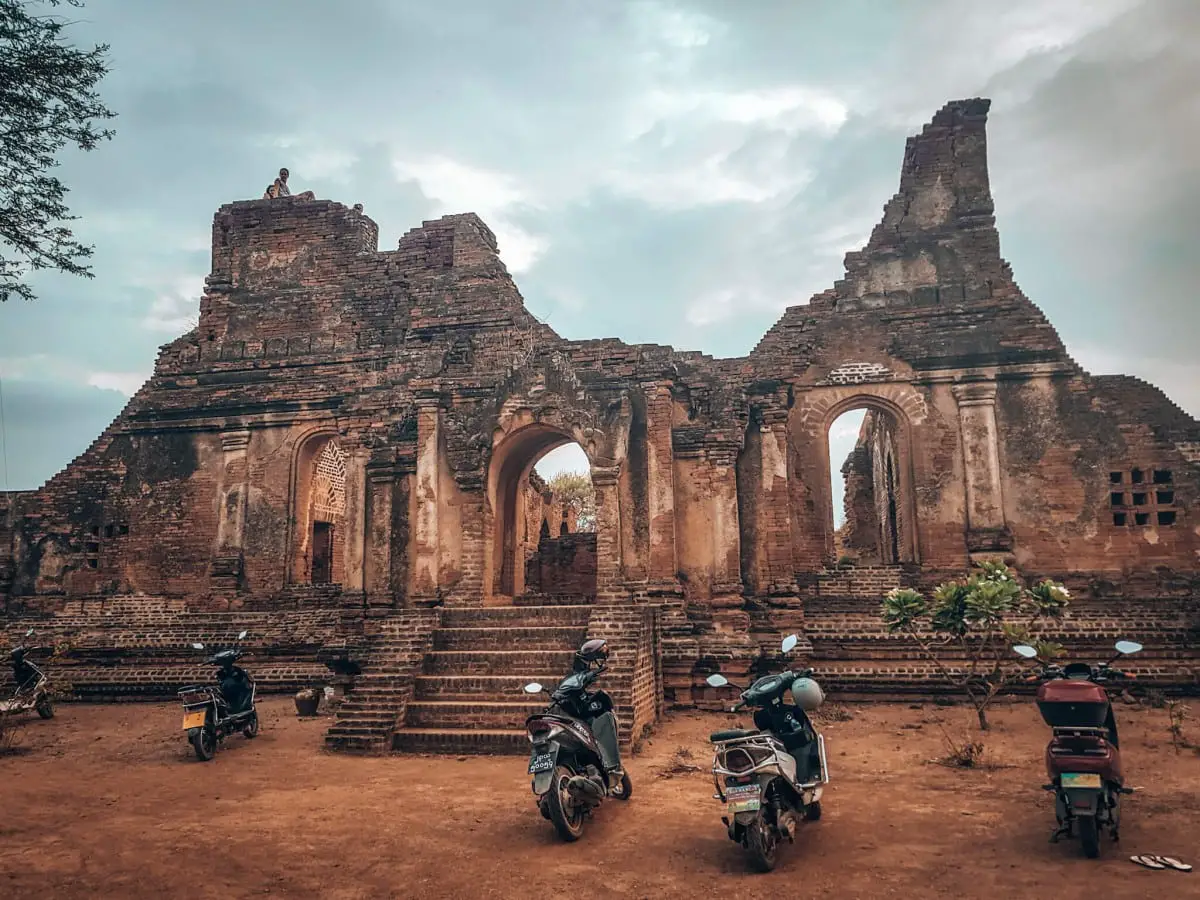
Local support
The pagoda closure has given rise to its own illicit industry, with enterprising locals waiting on their mopeds to turn into a travel guide for you. They’re on most corners so you can’t miss them. Give them a small cash incentive (about 6 USD/5 GBP), and follow them to a temple where police aren’t in the area.
Often these locals are also in partnership with police and seem to use some of your fee to pay them off. This seems the safer of the two pagoda climbing options but still be warned: This is still illegal and you might hurt yourself scaling a temple not built for it. We saw a girl almost fall off the side while navigating a tricky turn in her billowing dress and bare feet.
If you still want to climb temples, pay a local but also be ready to pay a fine.
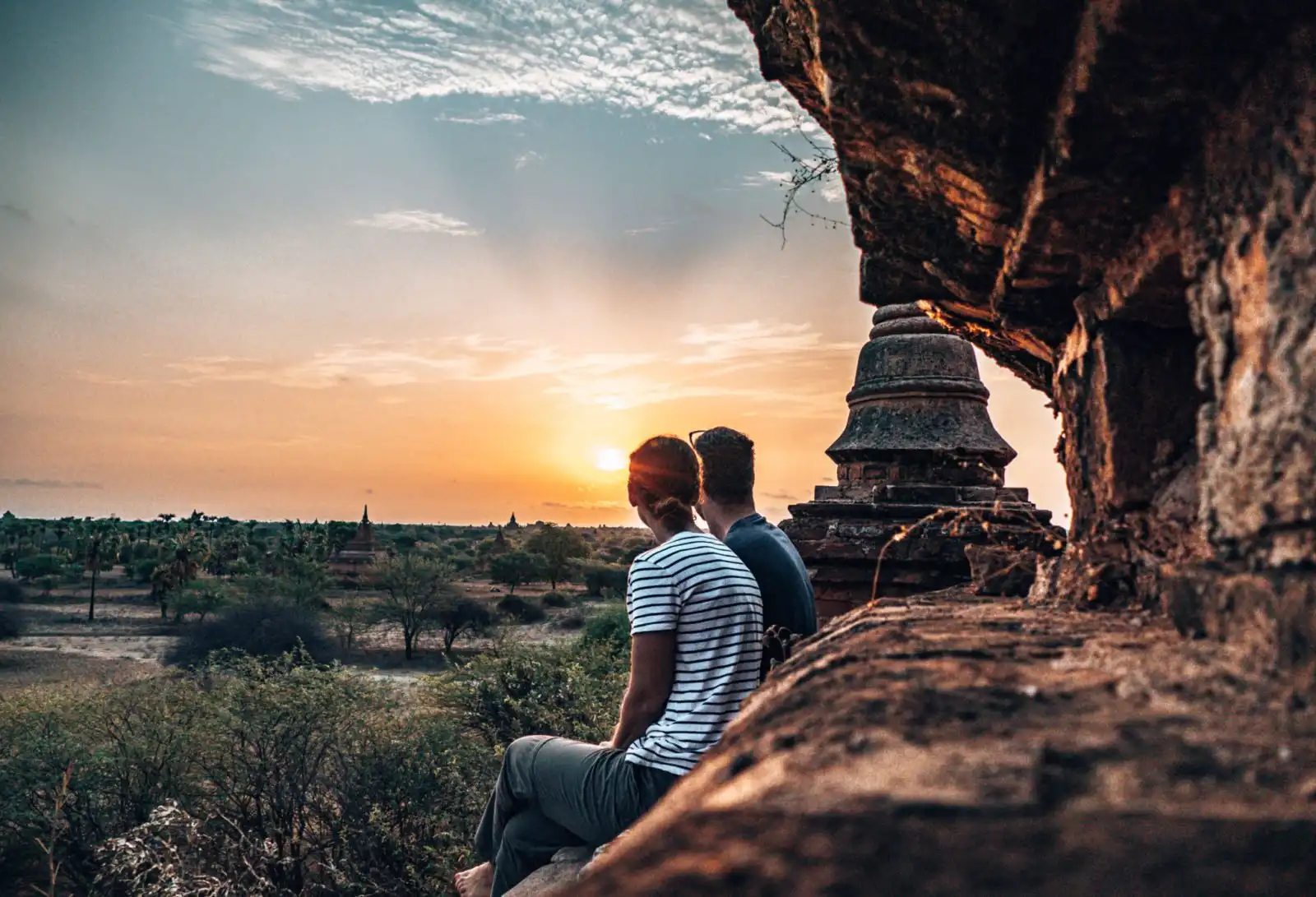
How to get around the Bagan temples
E-bike
Really the best (and only) way to truly have a great temple-hopping experience in Bagan is to rent an electric bike from your hotel or hostel (it’s around 5,000 MMK / 3.50 USD / 2.80 GBP per day) and use maps.me. It is far better than Google Maps who don’t have a great Bagan temples map.
Other travellers are always updating the locations with advice on whether police loiter, the quality of the view and how busy it is at certain points, particularly since the larger viewing points are increasingly heaving with tourists, brought in on large tour coaches for the day.
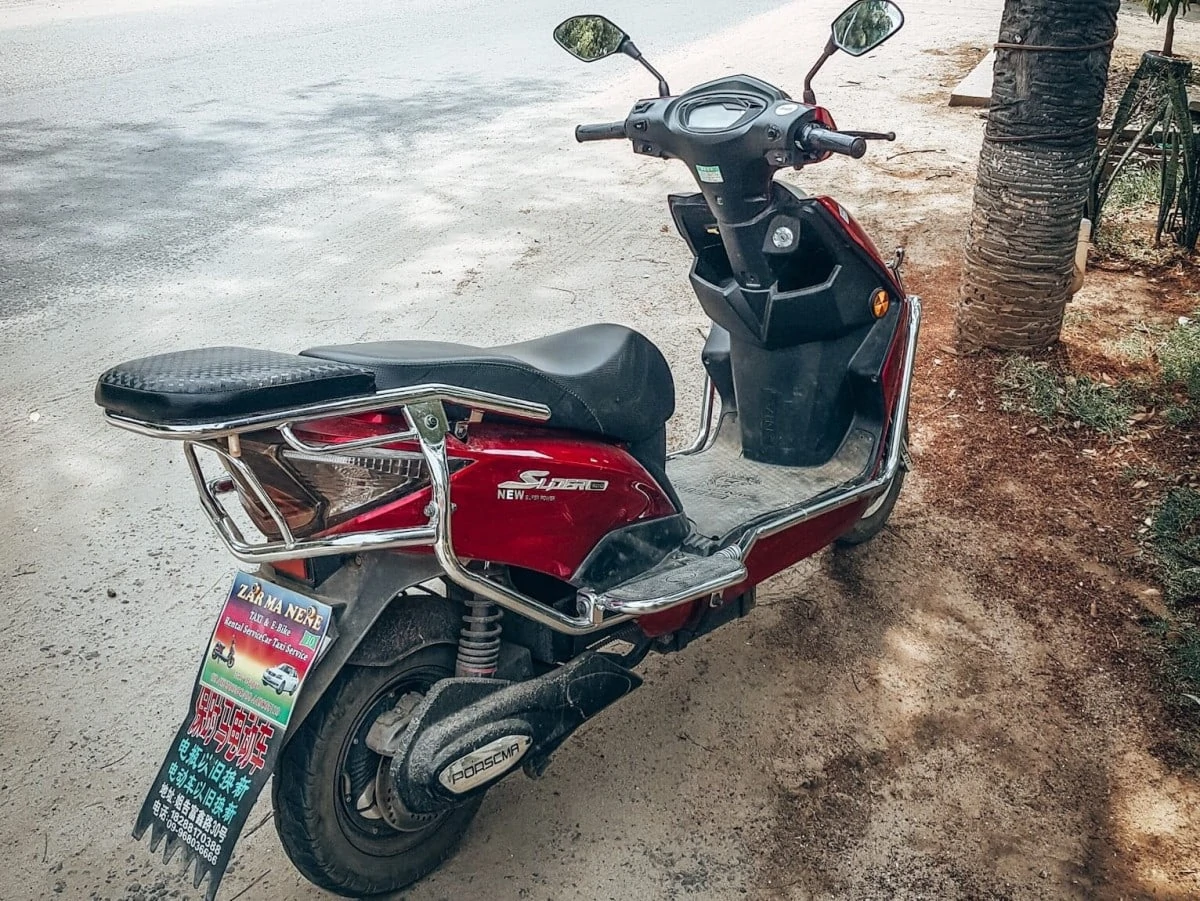
Because the temple situation changes so often, maps.me is the most up to date way to traverse the Bagan plains; even more so than our map below!
Note: Tourists can only rent e-scooters, not actual mopeds or motorbikes. It’s the local rules. These work well enough to get around town though. You can also of course rent a traditional bicycle but since Bagan is very hot, this might be a sweaty pursuit!
Hot-air balloon
Well other than hiring your own e-scooter and visiting the temples, if you’re in Bagan during the right months (October to April) then seeing the temples from the air has to be the BEST way to see how massive Bagan really is!
Hot air ballooning over Bagan really is a once in a lifetime experience. Check out some of the latest hot air balloon ride options here.
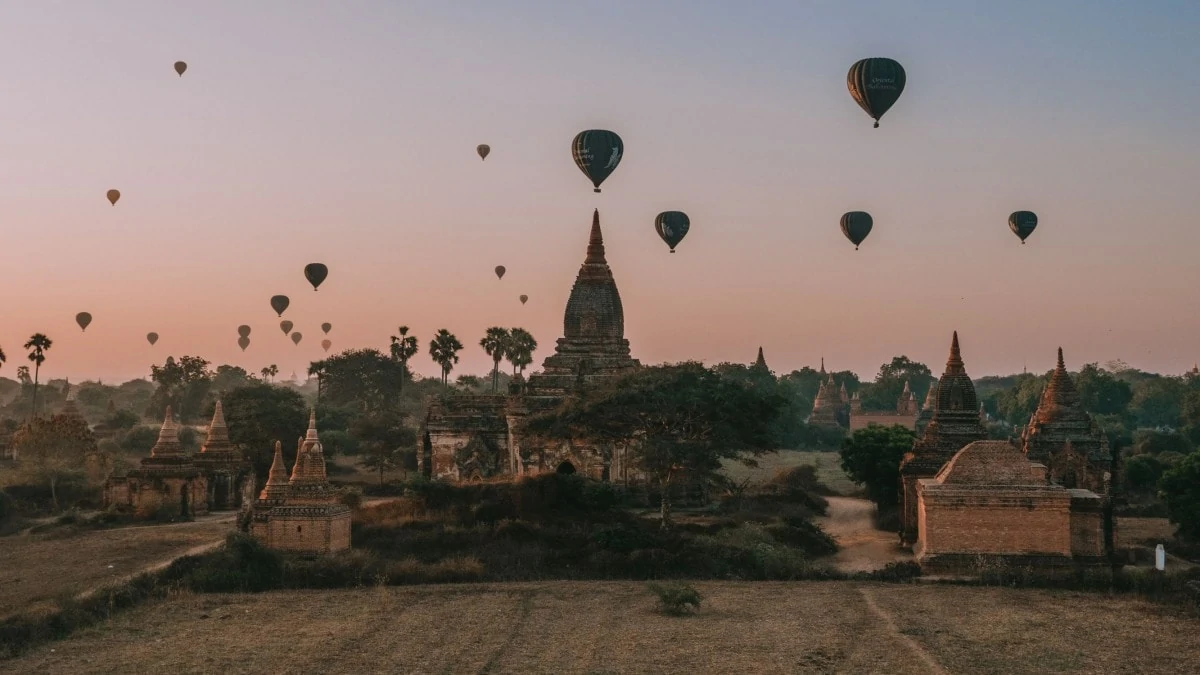
Guided Tour
So, what do you do if you can’t ride a scooter?
Well, if you can’t ride one, then we would suggest that you look for a Bagan tour guide as there really isn’t another way to do it… we’d recommend this one.
You can also try to explore further afield, like a 2 hour day trip from Bagan out to Mount Popa, an epic extinct volcano with temple atop! Here’s a tour option to explore.
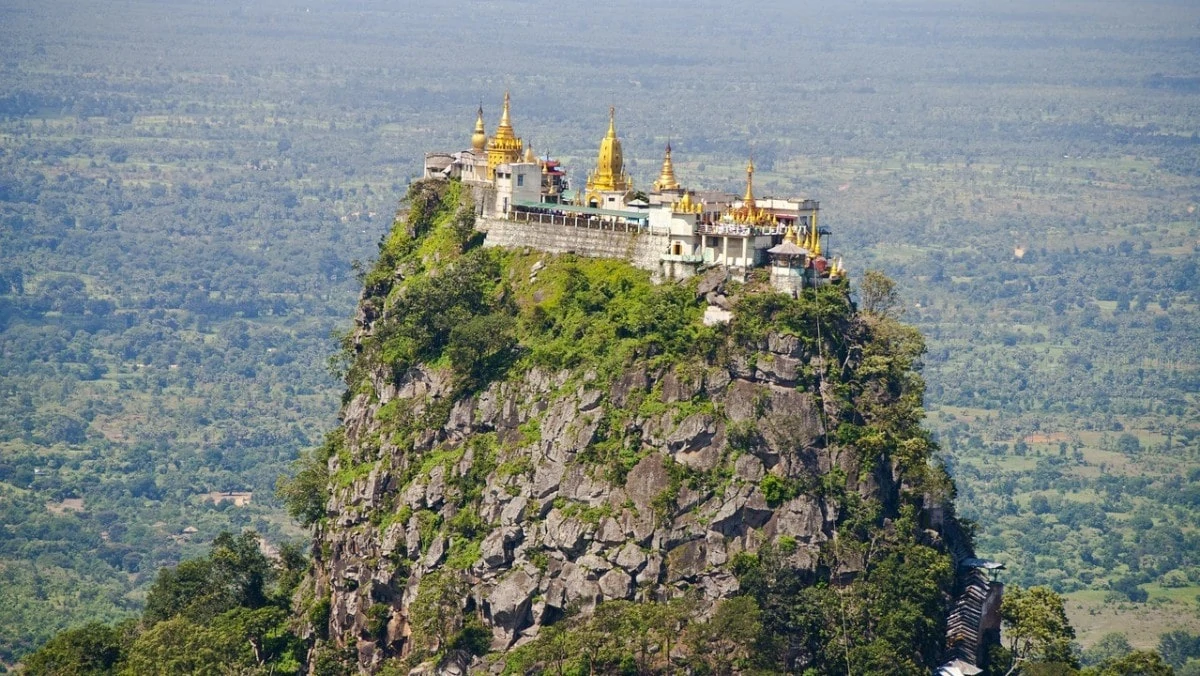
Bagan Temples Map
Here’s a handy Bagan map. This is a Google map which, unlike maps.me, you can’t edit. However, if you click the icon on the top right, you can save it to your own device’s Google Maps for easy access.
Best places to view the temples
There are a few viewing mounds and temple ruins that you can still visit perfectly legally! We’ve included their details below and in our Bagan temples map for you.
Sunset Ruins
Great for sunset although overlooking a small batch of houses, this ruin is climbable. We really enjoyed this one, especially since some kids were playing sepak trawak the entire time we were there!
Co-ordinates: 21.140082, 94.868238
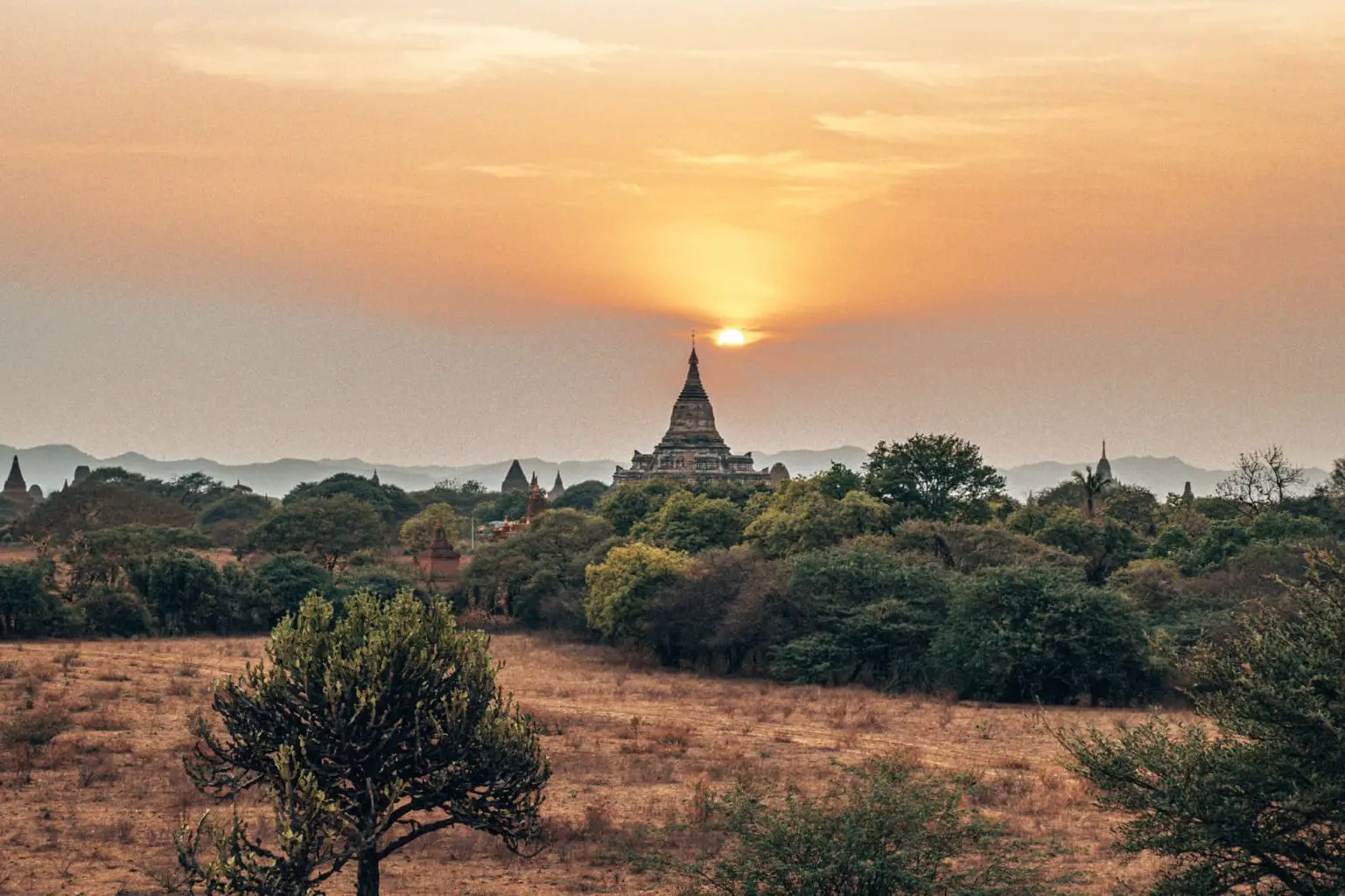
Sunset Hill
A man-made viewing mound, good for sunset
Co-ordinates: 21.152368, 94.890297
O Bo Gon Hill
Another sunset viewing point on a manmade mound
Co-ordinates: 21.161965, 94.88862
Sunrise Ruins
Our favourite sunrise spot, you watch the sunrise peek out behind the amazing Dhammayangyi temple. This is a ruin turned into a mound.
Co-ordinates: 21.161795, 94.871384
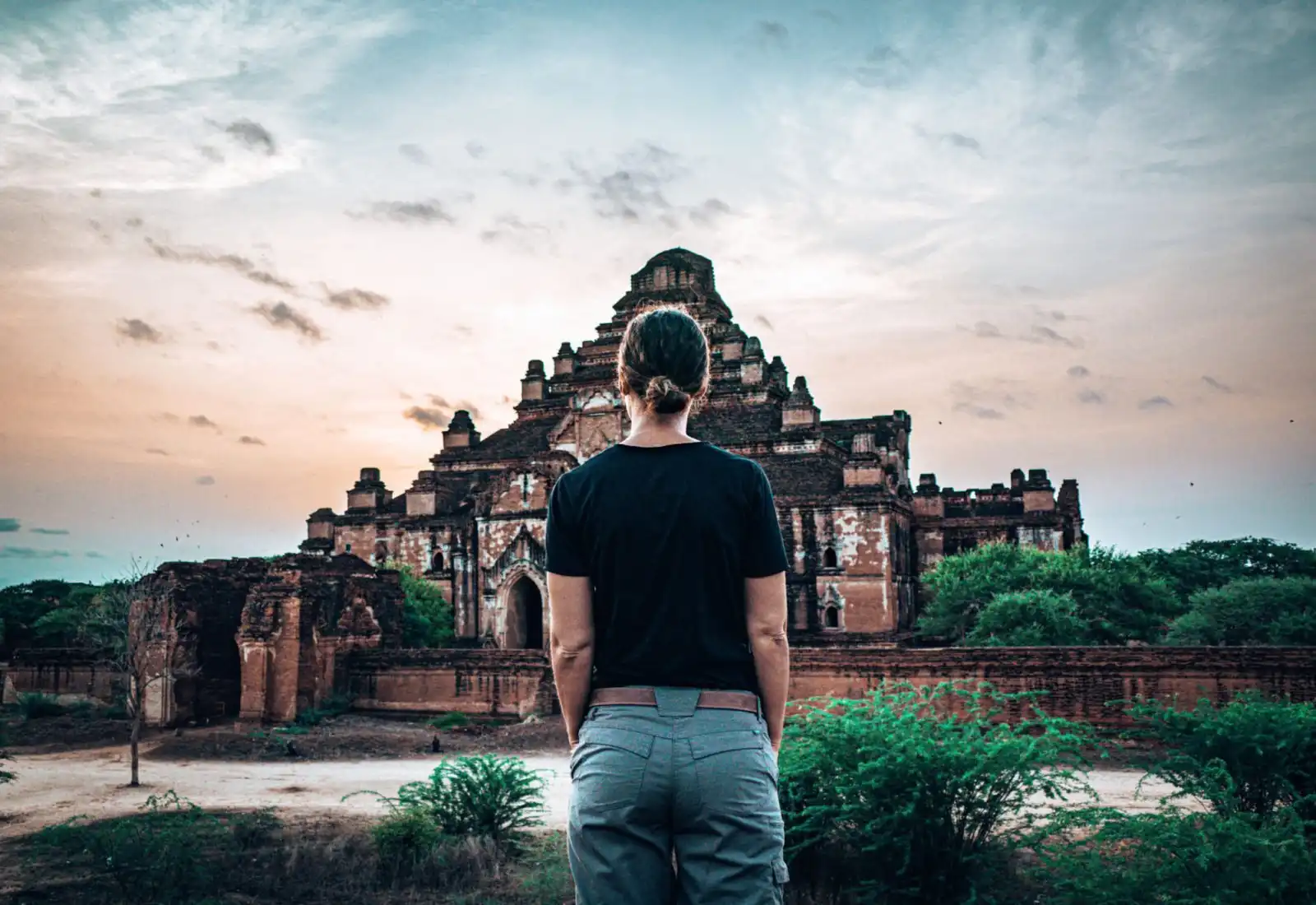
If you’re looking for an alternative way to view the sunset, you could also try the Erawati Raft. It’s a boat turned floating restaurant which has surprisingly delicious food (think curry and fried rice) and passable cocktails at reasonable prices, with an incredible sunset view over the Irrawaddy River.
The best Bagan temples to visit
To be honest, there are so many beautiful Bagan temples to visit that it’s hard to pick just a few. However, here is our best Bagan pagoda list:
Dhammayan Gyi Temple – Our favourite in Bagan, this ‘unfinished temple’ is right out of a movie set. Built by King Narathu, who came to the throne by killing his father!
Shwesandaw Pagoda – Arguably the most famous in Bagan, Shwe San Daw Pagoda is unfortunately because it’s not climbable, you might find this a bit underwhelming. However, many don’t know there is an 18 metre long reclining Buddha in the brick structure alongside it – don’t miss it!
Ananda Temple – A beautiful temple with less traditional cream-coloured walls, this is a cool place to come in the morning after your sunrise jaunts.
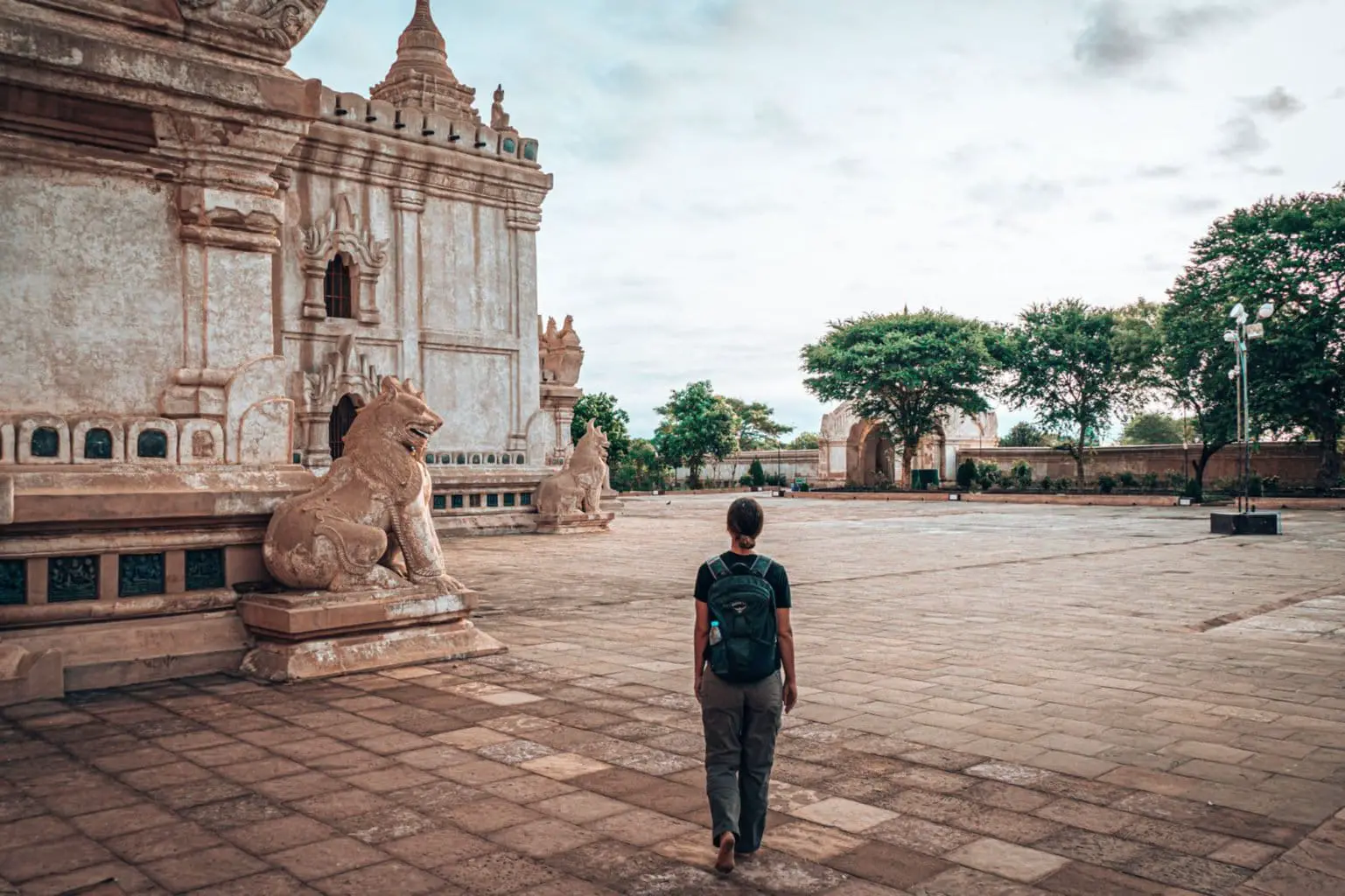
Thatbyinnyu Temple – Next to the Ananda Temple, and built in the 12th century by King Alaungsithu, this unique temple is shaped like a cross.
Sulamani Temple – under renovation when we were there, but known to be an impressive temple to visit.
Shwezigon Pagoda – one of the oldest temples in Bagan this is a one story pagoda with a glittering gold roof. If you visit in October or November there is also a festival held at this site that’s worth checking out.
Unnamed secret temple Bagan – our spot for sunrise where you need the help of a local (enough said ?)
Co-ordinates: 21.149851, 94.870982
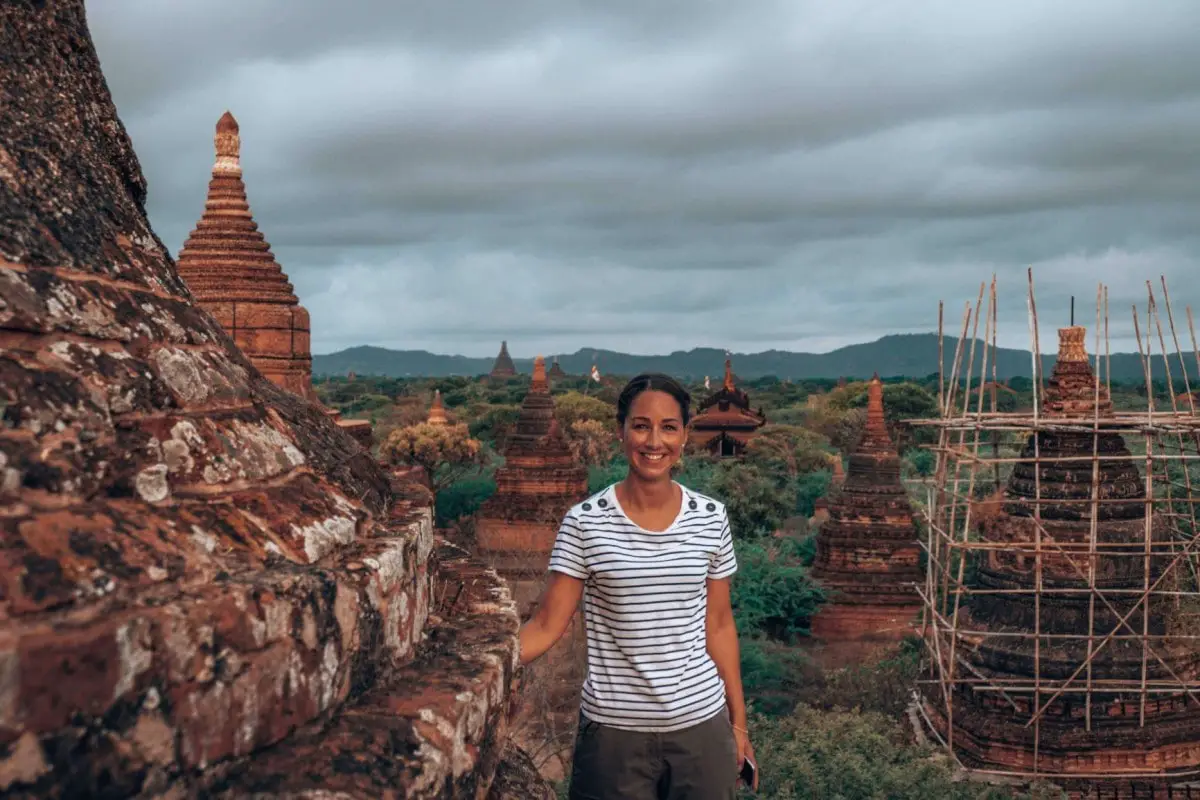
What is the cost for the Bagan temples?
Not many people realise, but there is a fee for entering into the temple complex. In fact, on arrival into Bagan via bus, train or plane, when you are transferring from transport stop to your accommodation you will be taken to an official road stop where you need to purchase a ticket.
The Bagan archaeological entrance fee is 25,000 MMK (kyat) per person (17.50 USD/14 GBP), so in comparison to somewhere like Angkor Wat, it’s relatively cheap. Although we were pretty disappointed to hear that only 5% of the ticket went to the restoration of the temples, the remainder went to the government.
Note: make sure you have the cash you need for purchasing your Bagan temple pass.
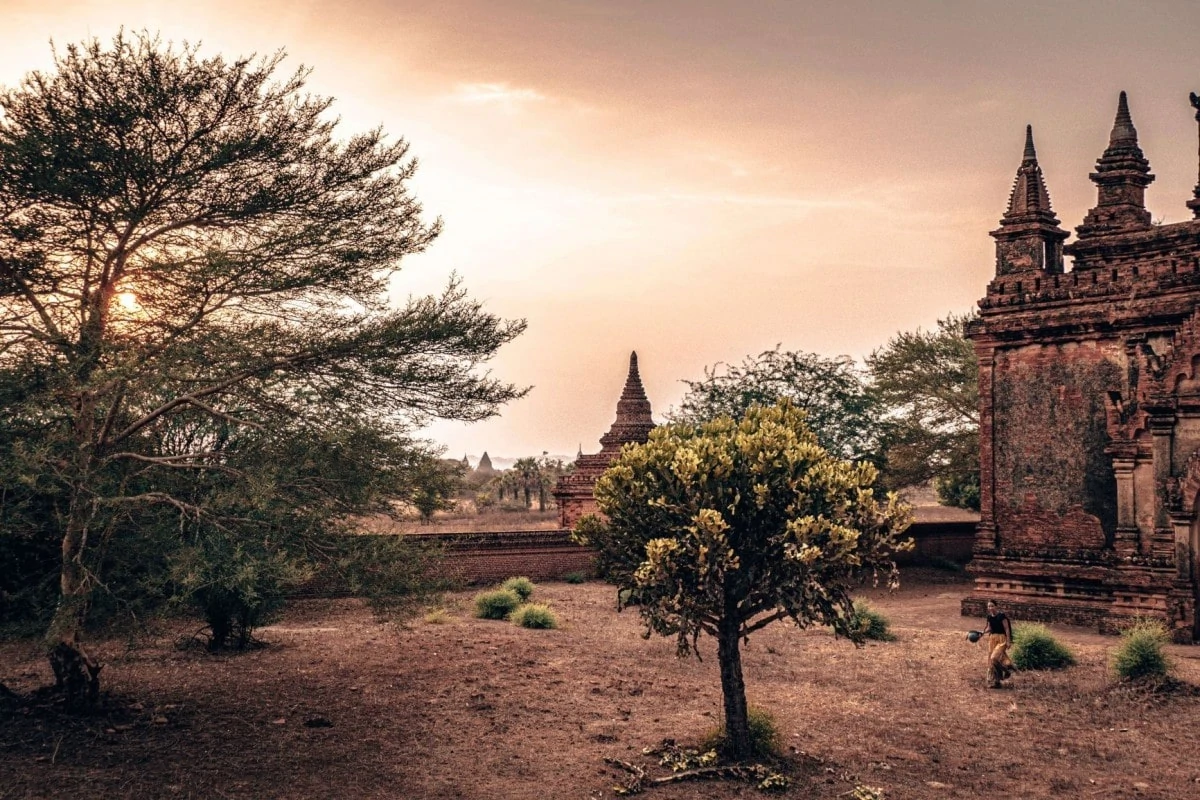
What are the best places to eat in Bagan?
We were pleasantly surprised by the number of really great food options in both Old Bagan and New Bagan… although if you’d ask us to name two absolute must-eat places:
Be Kind to Animals the Moon has two branches, one in Old and one New Bagan. The food at both is amazing, although we slightly preferred the setting of the one in New Bagan. This vegetarian restaurant has one of the best veggie burgers we’ve ever eaten.
Want to try some local street curry, then Ma Mae Naing (also known as Unforgettable) has the best we had in Myanmar. And for around 2,500 MMK (1.75 USD/1.40 GBP) for a 3 course curry, it was also one of our cheapest meals in Asia.
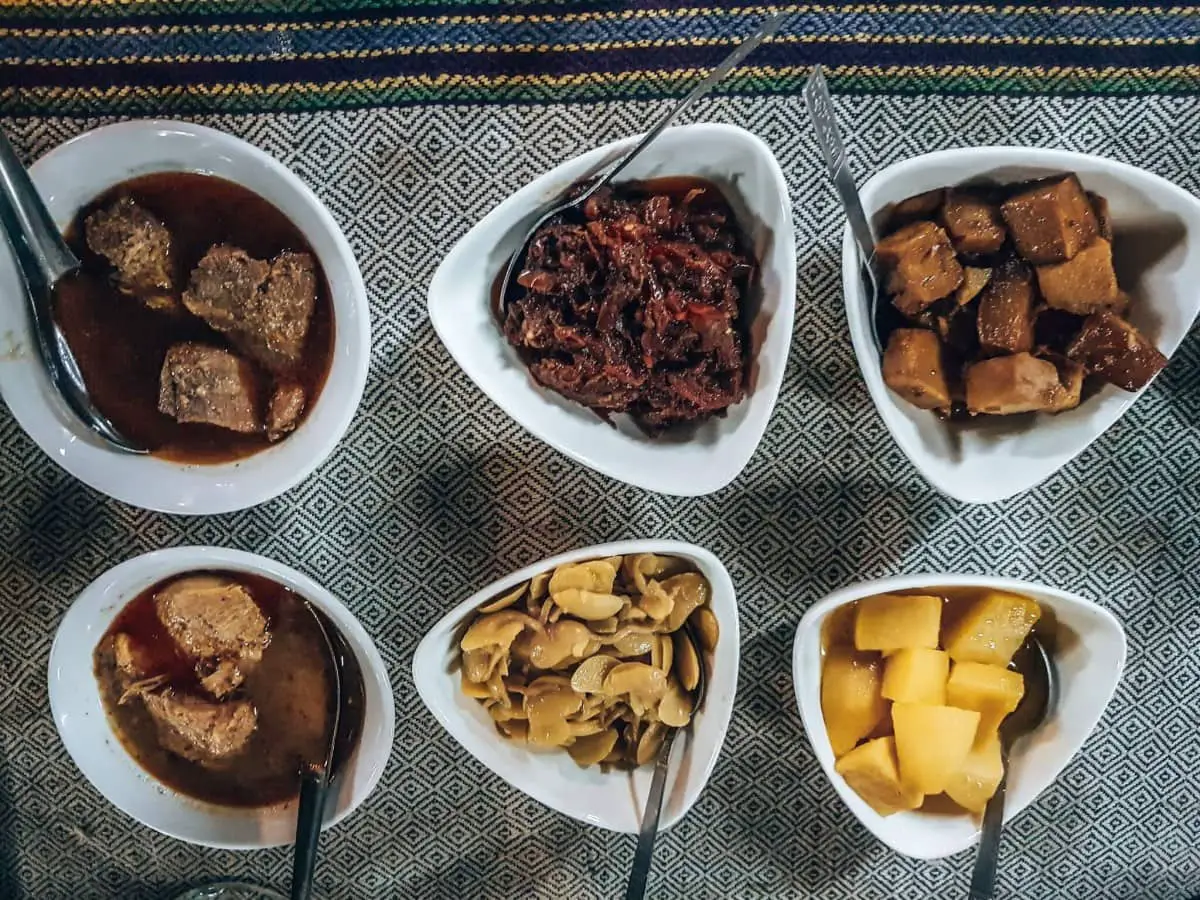
Where to stay in Bagan
The town is really split into three areas: Old Bagan which houses some of the older, most traditional hotels, New Bagan which includes hostels and some newer villa options and Nyaung-U which boasts a good mix of accommodation but is a bit further away from the temples themselves.
So, what are the best hotels in Bagan?
Personally we enjoyed staying in New Bagan at Villa Bagan, a mid-priced boutique Bagan hotel with a lovely pool (ideal to cool off on the scorching hot days). And not to mention the view from the hotel roof was fantastic.
Many travellers we met stayed at the infamous Ostello Bello hostel, also set in New Bagan, which is a very sociable hostel, complete with trivia nights, a great happy hour and a nearby swimming pool complex. They also have a sister hostel in Mandalay which we also enjoyed.
Also, if you’re looking for more of an itinerary for Bagan, we like this 3 day Bagan itinerary.
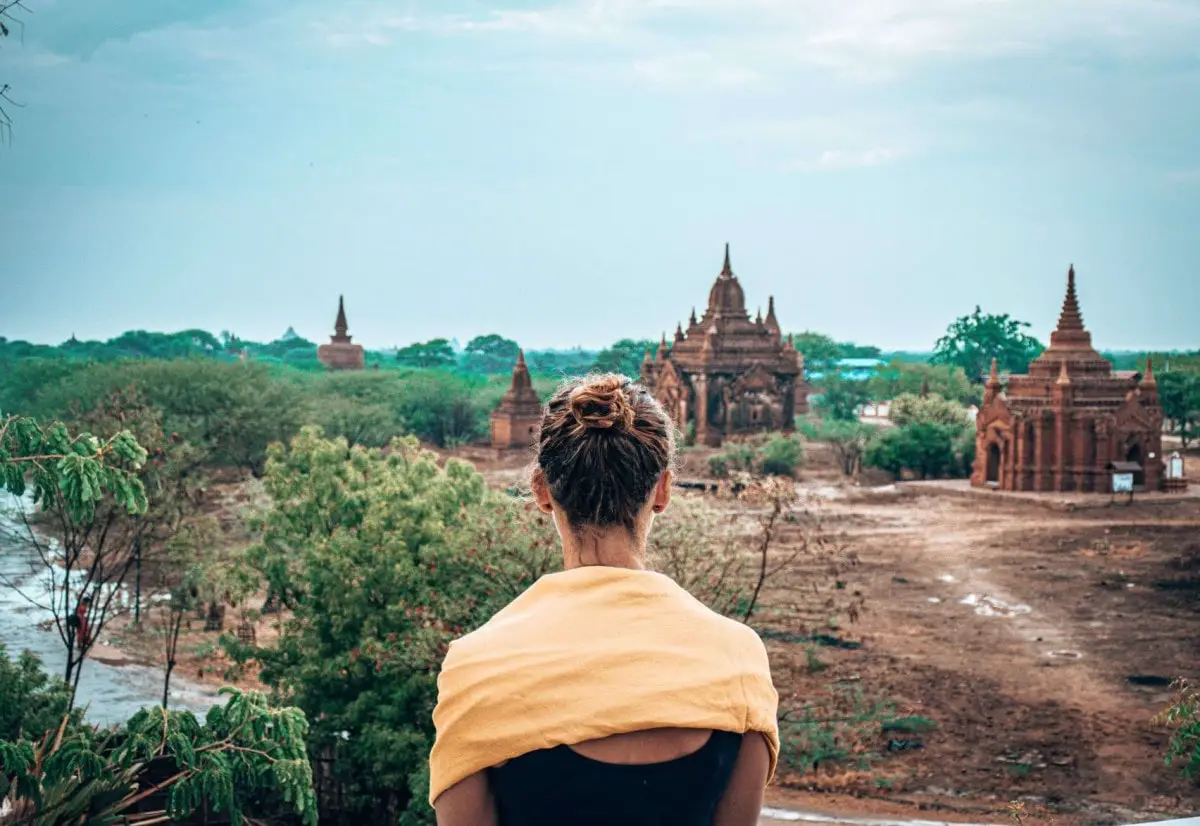
When is the best time to visit Bagan Myanmar?
If you’re looking for those picture-perfect photos, with hot air balloons dotting the temple-ridden skyline, then you’ll want to visit between October and April.
The best months are during the cooler season from November to February, as you may get the odd downpour in October, and by March the temperatures are really ramping up.
We visited in May and it was unbearably hot during the heat of the day. At points on the e-bike it felt like riding through an oven. But we had perfect weather for sunrise, rest, sunset repeat.
Definitely avoid the wet season from June to September. Adding some rain to the dusty sandy roads would make exploring somewhere from interesting to impossible.
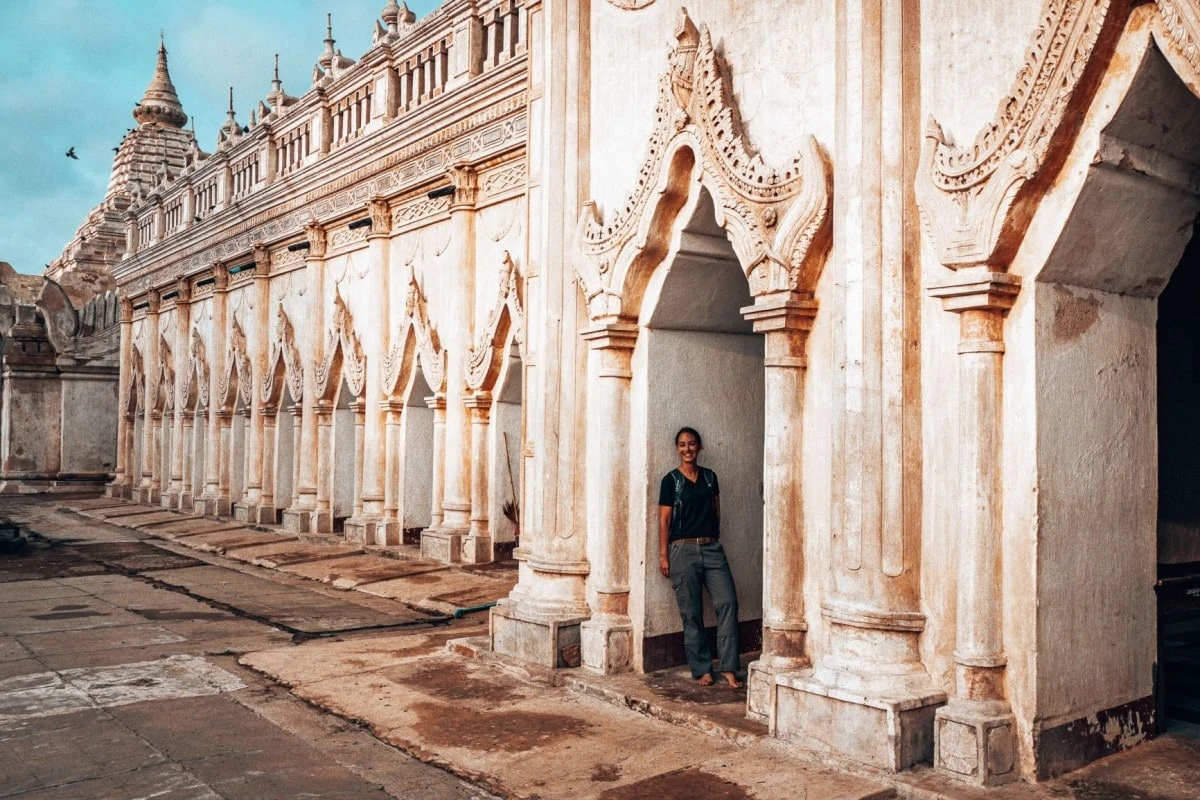
What to pack for Bagan?
Alongside the usual clothes, if we were asked what the essentials are to take with us, these would be out top recommendations:
- Reusable filtration bottles – try out Lifestraw, saving the planet one plastic bottle at a time
- Bandana – driving the dusty roads, these are a lifesaver
- Sunscreen and sunglasses. It’s hot.
- Long sleeves, trousers or long skirts for temples – the Bagan temple dress code dictates that you make sure you cover up and dress modestly when visiting these places of worship.
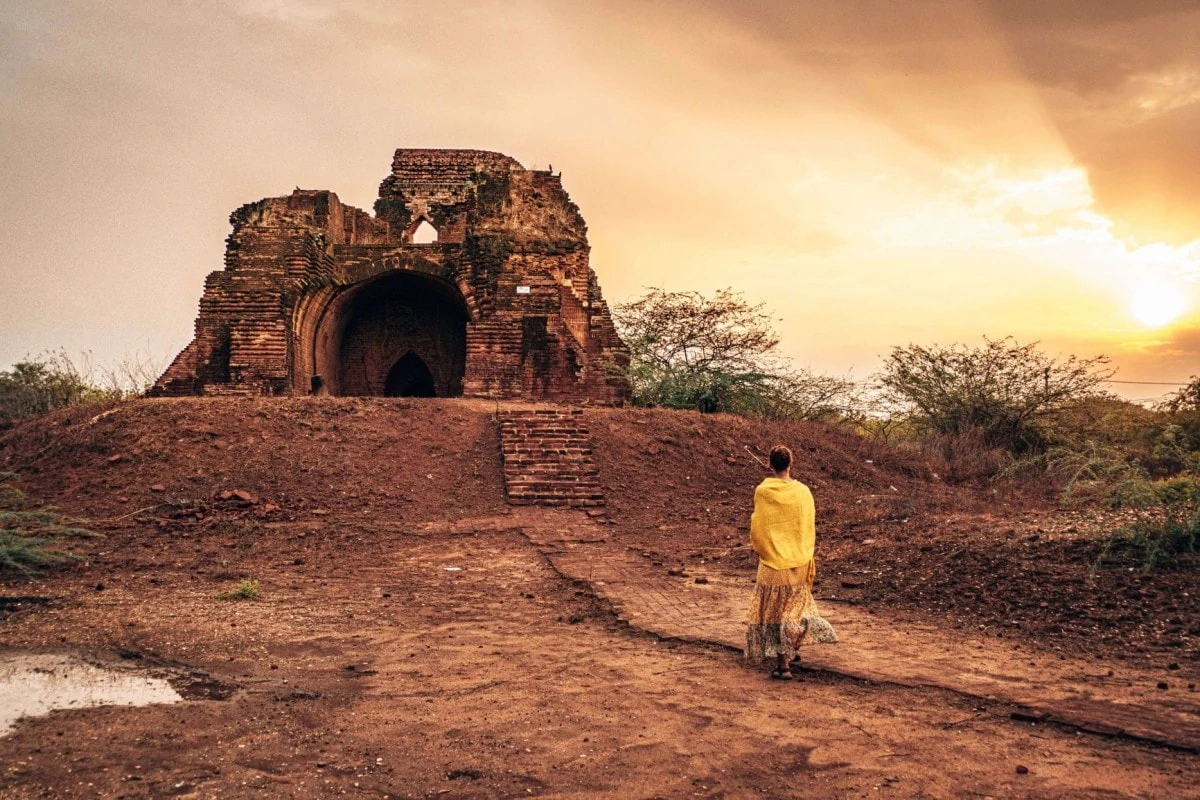
What camera equipment and other gear do we use?
We’re living proof that you don’t need the most expensive gear to travel the world and take good photos. Here are some of our must have items that make it into the packing list for all our travels.
- Main Camera: Panasonic Lumix FZ1000
- Drone: DJI Mavic Air – Fly More Combo
- GoPro: Hero 7 Black
- GoPro Dive Case: Go Pro Housing
- GoPro Case: Smatree GoPro Carry Case – Small
- Packing Cubes: Eagle Creek Packing case
- Backpack: Osprey Farpoint 70
- Powerbank: Anker Powercore
- Phone: Xiaomi Mi 9
- Hard drive: Transcend Slim Storejet 2TB
- Laptop: Lenovo IdeaPad 720s
- Headphones: Bose Quiet Comfort 35
- Wifi Hotspot: GlocalMe G4
Did you enjoy our Bagan Ultimate Travel Guide, complete with Bagan temples map? Do let us know in the comments!
Want to save this for later? Why not pin it…
